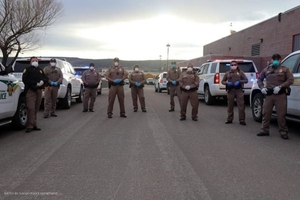
- Details
- By Native News Online Staff
WINDOW ROCK, Ariz. — On Tuesday, the Navajo Department of Health issued Public Health Emergency Order No. 2020-24, which revises the daily curfew during weekdays from 8:00 p.m. to 5:00 a.m. starting on Friday, Oct. 2, 2020, and implements two additional 57-hour weekend lockdowns as the result of increases in COVID-19 cases in many regions of the Navajo Nation. The 57-hour weekend lockdowns will begin at 8:00 p.m. (MDT) on Friday, Oct. 2 until 5:00 a.m. (MDT) on Monday, Oct. 5 and continuing the weekend lockdown for the same 57-hour time period on Oct. 9-12, 2020. The Stay-At-Home Order also remains in effect for the entire Navajo Nation.
On Tuesday, the Navajo Department of Health, in coordination with the Navajo Epidemiology Center and the Navajo Area Indian Health Service, reported 20 new COVID-19 positive cases for the Navajo Nation and no recent deaths. The total number of deaths remains 555 as previously reported on Sunday. Reports indicate that 7,255 individuals have recovered from COVID-19, and 106,194 COVID-19 tests have been administered. The total number of positive COVID-19 cases is now 10,333, which includes one additional positive case due to delayed reporting from health care facilities.
According to information provided by the Navajo Epidemiology Center and contact tracers, the increase in COVID-19 cases is directly related to residents traveling off of the Navajo Nation, and family gatherings where social distancing and the wearing of face masks are not enforced.
The new public health emergency order also allows Navajo Nation residents to collect and haul wood during the 57-hour weekend lockdown, as long as wood haulers obtain a permit from the Navajo Nation Forestry Department. Wood hauling groups are limited to no more than five people and are required to wear masks, maintain social distancing, and use hand sanitizer.
“It only took a few people traveling off our Nation to have wide spread increases in cluster cases in several regions of the Navajo Nation. The only way we are going to reduce the spread of the virus is by adhering to the recommendations and public health emergency orders issued by our public health experts. With the latest public health order, the Nation is allowing residents to collect and haul wood, as long as a permit is secured, in preparation for the winter season. Please use this time wisely and plan ahead to ensure your health and safety,” Navajo Nation President Nez said.
Nearby counties and states have also reported increasing numbers of COVID-19 cases, which adds to the overall risk for residents who travel off the Navajo Nation. According to the Centers for Disease Control and Prevention, “Limiting face-to-face contact with others is the best way to reduce the spread of coronavirus disease” and "the more closely you interact with others and the longer that interaction, the higher the risk of COVID-19 spread.”
“It’s very alarming to see the number of cluster cases rise in various regions of the Navajo Nation, but we have the ability to once again reduce the number of cases. The road ahead is challenging, but we have to remember that the strength and resilience of our ancestors remains within each of us to this day. We will overcome this pandemic together. Please continue to pray for our people and our first responders,” said Vice President Myron Lizer.
Essential Employees reporting to or from duty are exempted from the weekend lockdown, but must carry official identification or a letter of designation from their employer on official letterhead which includes a contact name and number for verification. All businesses including all stores, gas stations, restaurants, drive-thru food establishments, hay and all other vendors are required to cease operations and close during the weekend lockdowns and daily curfew hours.
Individuals are permitted to conduct farming activities and tend to livestock, however livestock owners must plan ahead to purchase hay and feed – hay vendors will not be allowed to sell during the weekend lockdown and daily curfew hours. Residents are also allowed to exercise outdoors within their immediate residential area or home site area during non-curfew hours.
More Stories Like This
Native News Weekly (August 25, 2024): D.C. BriefsUS Presidents in Their Own Words Concerning American Indians
Monday Morning (December 22, 2025): Articles You May Have Missed This Past Weekend
Read What Our Year-End Campaign Donors Are Saying
Michigan Legislature Takes Action to Honor Civil War Native Sharpshooters
Help us defend tribal sovereignty.
At Native News Online, our mission is rooted in telling the stories that strengthen sovereignty and uplift Indigenous voices — not just at year’s end, but every single day.
Because of your generosity last year, we were able to keep our reporters on the ground in tribal communities, at national gatherings and in the halls of Congress — covering the issues that matter most to Indian Country: sovereignty, culture, education, health and economic opportunity.
That support sustained us through a tough year in 2025. Now, as we look to the year ahead, we need your help right now to ensure warrior journalism remains strong — reporting that defends tribal sovereignty, amplifies Native truth, and holds power accountable.
 The stakes couldn't be higher. Your support keeps Native voices heard, Native stories told and Native sovereignty defended.
The stakes couldn't be higher. Your support keeps Native voices heard, Native stories told and Native sovereignty defended.
Stand with Warrior Journalism today.
Levi Rickert (Potawatomi), Editor & Publisher

